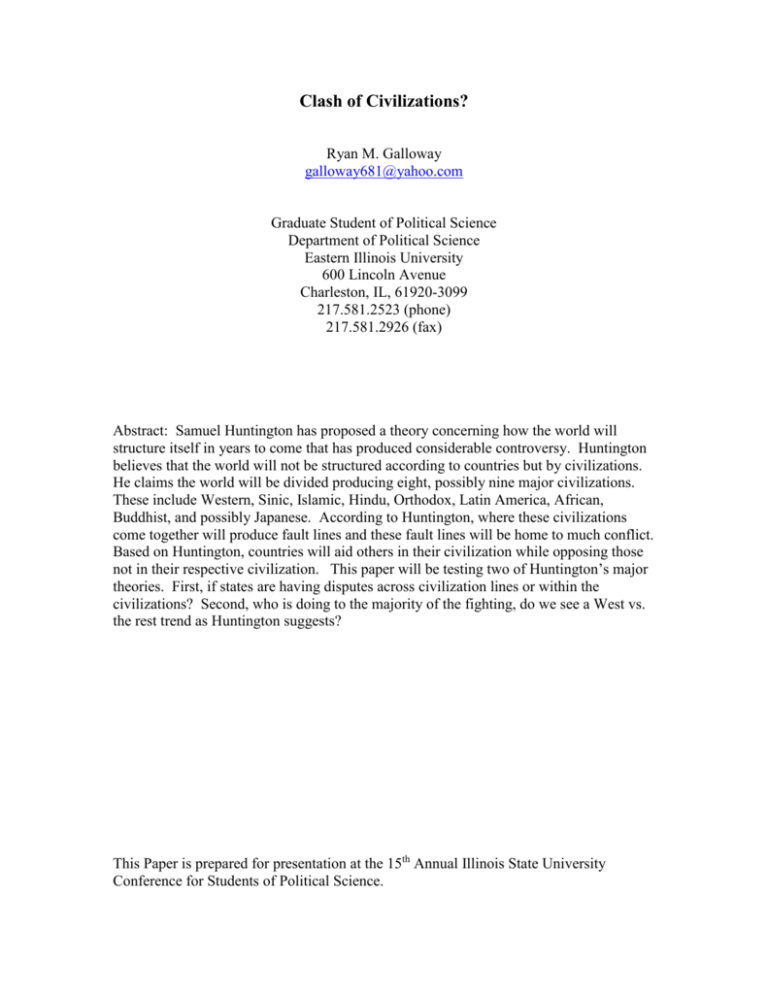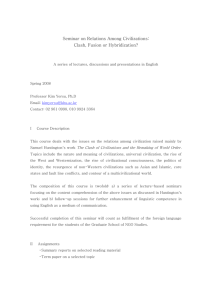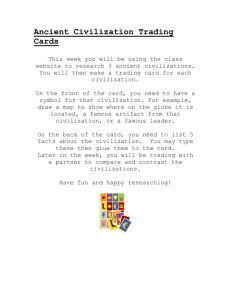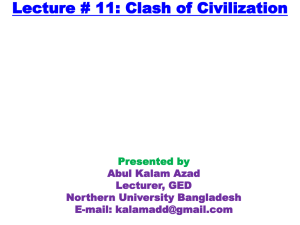Clash of Civilizations - Politics and Government| Illinois State
advertisement

Clash of Civilizations? Ryan M. Galloway galloway681@yahoo.com Graduate Student of Political Science Department of Political Science Eastern Illinois University 600 Lincoln Avenue Charleston, IL, 61920-3099 217.581.2523 (phone) 217.581.2926 (fax) Abstract: Samuel Huntington has proposed a theory concerning how the world will structure itself in years to come that has produced considerable controversy. Huntington believes that the world will not be structured according to countries but by civilizations. He claims the world will be divided producing eight, possibly nine major civilizations. These include Western, Sinic, Islamic, Hindu, Orthodox, Latin America, African, Buddhist, and possibly Japanese. According to Huntington, where these civilizations come together will produce fault lines and these fault lines will be home to much conflict. Based on Huntington, countries will aid others in their civilization while opposing those not in their respective civilization. This paper will be testing two of Huntington’s major theories. First, if states are having disputes across civilization lines or within the civilizations? Second, who is doing to the majority of the fighting, do we see a West vs. the rest trend as Huntington suggests? This Paper is prepared for presentation at the 15th Annual Illinois State University Conference for Students of Political Science. Introduction Back in the days of the cold war everything was much more predictable. Russia would represent communism and try to get other countries to do the same; the United States would represent democracy and try to get other countries to do the same. The world might not have been stable, as the arms race spiraled more and more out of control, but at least we knew were we stood and who our enemies were with a high degree of certainty. The United States and Russia were mortal enemies and consequently each side developed a following. During this time period countries got along or worked with each other not necessarily because they liked each other or what they stood for, but for protection against a common enemy. Everyone who was against Russia and communism had a united goal, to deter Russia and defeat communism. It might not have been pretty but at least the world had a balance of sort. Then Russia fell and communism was defeated. All of a sudden countries that had been cooperating in a common goal to defeat Russia no longer had to cooperate anymore. The glue that had held everything together had evaporated. With this major world change many people wondered what would happen to international relations, would countries continue to cooperate? One man who has an idea concerning this new phase of world politics we entered is Samuel P. Huntington. Huntington’s ideas on how the world will structure itself now that Russia has fallen and the United States has emerged as the sole world power have produced a lot of controversy. Huntington believes that the world will not be structured according to countries but by civilizations. He claims that; “A civilization is thus the highest cultural grouping of people and the broadest level of cultural identity people have 1 short of that which distinguishes humans from other species” (Huntington 1993, 24). Huntington claims that the world will be divided producing eight, possibly nine major civilizations. These include Western, Sinic, Islamic, Hindu, Orthodox, Latin America, African, Buddhist, and possibly Japanese. According to Huntington, where these civilizations come together will produce fault lines and these fault lines will be home to much conflict. Based on Huntington, countries will aid others in their civilization while opposing those not in their respective civilization. At the heart of the civilization battle is the West vs. the other civilizations, which will result in massive conflict as these civilizations fight it out. There is a lot of controversy surrounding Huntington’s ideas as many people question his theories in light of globalization and a seemingly shrinking world. There have been many efforts to refute Huntington including an article done by Russett (2000). The data that was available to him was only through 1993. I am doing this research in order to extend Russett’s research and further test some of Huntington’s major theories. I will be testing two of Huntington’s major theories. First, if states are having disputes across civilization lines or within the civilizations? Second, who is doing to the majority of the fighting, do we see a West vs. the rest trend as Huntington suggests? 2 Literature Review Samuel Huntington’s argument of a clash of civilizations has provoked a lot of thought and in turn, spurred a considerable amount of critique and criticism. Huntington argues that although nation states will remain the most powerful actors in world affairs and that the principle conflicts will take place between nations and groups of different civilizations (Huntington 1993, p.23). Huntington believes that the world has organized itself into separate civilizations and it is along this organizational level that individuals identify themselves rather than by national identity (Huntington 1993, 1996). There are others who do not believe that the civilization unit of analysis carries much weight and that there are more important cultural factors that need to be examined within the civilization to explain conflict. Malitza claims that there is only one civilization, but thousands of cultures. Malitza goes about explaining conflicts on a cultural level, undermining the broad civilization argument of Huntington. Malitza explains that Huntington has mistaken civilization for culture and that he has not accounted for enough. She claims that Huntington overestimates the large conflicts at the expense of the importance of the local intra-civilization clashes. She points to Bosnia as an example. The parties involved in the conflict are from the same civilization but they clashed on cultural merits (Malitza 2000, p.78). 3 Huntington believes that civilizations will clash for a number of reasons. Huntington claims that civilizations are different from each other with regards to history, language, culture, tradition, and most importantly, religion. He claims that historically, these cultural differences have produced the longest and most violent conflicts (Huntington 1993, p.25). Henderson provides evidence to the contrary. He states that based on examination from 1820-1989, cultural similarities actually increase the probability of conflict. While he does claim that a common religion between two states does lend to an increased probability of peace, perhaps these two factors cancel each other out. Henderson also reports that neighbors are more likely to clash than non neighbors, but not for the same reasons as Huntington claims. Henderson claims that neighboring states are more likely to fight over natural resources, and territory (Henderson 1998, p.463-467). Russett claims this evidence put forth by Henderson weakens Huntington’s claims of intense civilization fault line clashes based on cultural disputes. Russett claims that many of the conflicts that Huntington points out along fault lines are those of neighboring states involved in the type of dispute put forth by Henderson that would be present regardless of civilization differences (Russett 2000, p.588). It has been stated that Huntington believes the world is organized into nine civilizations. These civilizations have produced fault lines where one stops and another begins. It is along these fault lines that Huntington believes the largest conflicts will take place (Huntington 1993). Some research by Gurr comparing the occurrence of conflicts 4 before the end of the cold war with occurrences after its demise produce results showing the levels to remain relatively constant rather than increasing as Huntington would have us believe. Furthermore, civilization clashes, or conflicts across civilization fault lines account for only 18 of 50 major clashes happening in 1993-1994 (Gurr 1994, p.356-57). The main premise of Huntington’s argument lies in the fact that Civilizations will separate themselves along defined fault lines and it is across these fault lines, not within, that the majority of major conflicts will occur over cultural differences. Russett examined the occurrence of military interstate disputes from 1950-1992 and found that these disputes do not follow the civilization fault line argument which Huntington suggests. Russett claims that military disputes, uses of force, or conflicts involving fatalities occur at the same level whether within a civilization or across civilization fault lines. In fact, Russett found that four of the eight states examined fought more among themselves than across civilization fault lines. Russett concludes by stating that; “Civilizations do not define the fault lines along which international conflict occurs. More relevant are the common bonds of democracy and economic interdependence that unite many states, and separate them from others.” (Russett 2000, p.602). Chiozza finds evidence refuting Huntington’s fault line clashes by extending the examined time period through 1997. In this research the author finds that the civilization factors affects border contiguity and regime type, but are not enough to generate conditions under which differences in religious, ethnic, or cultural factors are associated with greater risks of conflict. Chiozza claims that; “At most, countries of different civilization are as conflict prone as countries of the same civilization” (Chiozza 2002, p.732). 5 Huntington claims that the clash of civilizations is most pronounced between the Western civilization against the rest of them. There are many reasons for this. Huntington claims that the West has had a devastating impact on every other civilization. According to Huntington, the West has dominated the rest of world by pushing its values and culture into other civilizations. As the rest of the world is becoming stronger and is gaining more confidence, aggressions against the West from the rest of the civilizations will become the major source of conflict (Huntington 1996, p.184). Fox has some research using the minorities at risk dataset comparing the cold war ear of 1945-1989 with the post cold war era of 1990-1998. He uses this dataset to examine the occurrence of conflict between the west and Islam, Islam versus the non-West, the West versus nonIslam. He also examines conflicts within the Islam civilization and within the Western civilization. The results of Fox’s study confirm Huntington’s claim that Western and Islamic civilizations engage in a considerable amount of civilization conflict, but the results do not show an increase in the post war era as Huntington hypothesizes. Further countering Huntington is the data showing that Islam versus West conflicts are a minority of civilization conflicts and conflicts between different civilizations are a minority of all ethnic conflicts (Fox 2001, p. 464-465). Huntington claims that Islam is the main challenger for the western civilization and further claims that Islam will join forces with the Sinic civilization (Huntington 1993, p.45-48). Rosecrance makes a good point that this would go against the civilization boundaries that Huntington has outlined and is arguing for ( Rosecrance 1998, p.979). 6 Methodology In order to test my research questions I will be examining instances of conflict between states and the extent that these do or do not extend across civilization boundaries. This study is concerned with extending or updating the study done by Russett in 2000 to include the new data available, which extends through 2001. This research will take a quantitative approach, as I will be using statistical data to test my questions. The data used to test the question posed in this research will be gathered from the Correlates of War Dataset. Russett examined the dataset that was available at the time which covered the years 1950-1992. I see no need to re-test his research so I will only be concerned with the new dataset which covers 1993-2001. The Correlates of War (COW) Database is extremely large as it contains many databases related to State relations. This research will only be concerned with the Dyadic Militarized Interstate Dispute Data. This dataset is a breakdown of the overall Militarized Interstate Disputes (MID’s), which are many times comprised of a number of participants, into actual disputing pairs of states. Each dyadic MID has two pairs of states involved on opposite sides of an MID. This dataset omits dyads where the two states were on opposing sides of a multi-party dispute but never took action against each other. There were around 300 MID’s from 1993-2001, but over 500 dyadic MID’s for this time period. The COW classifies an instance of dispute as an instance in which a threat of use of force is made by one of the two parties. In the data, a dispute is classified on a scale of 1-21 ranging from threat to use of force through interstate war. In the codebook for this dataset, Ghosn and 7 Bennett describe the dyadic MID nicely with a hypothetical situation. If an MID involves the US, Canada, and Britain this would be counted as one MID. But in the dyadic MID it would depend on the actions taken by the individual countries. For example, if the MID began with a threat by the US against Canada that would be one dyadic MID. Then if Britain joined forces with Canada and attacked the US this would start another dyad in which the US is on one side and Britain is on the other. In the end, this one MID would be divided into two separate ones. I believe that examining MID’s in the dyadic framework is the best way to test the questions I am concerned with as it gives more detailed information. I am concerned with the relationships between states in relation to civilization boundaries. In order to do this I need to measure all instances of dispute between states. The dyadic MID dataset enables this by segregating each instance of conflict between two states. In this research, I am taking a broad view of interstate dispute by allowing all threats of force into the examination as well as the more concrete uses of force. This approach is best for this examination based on the answers that are being sought. Huntington’s theory is concerned with inter-civilization relations. Threats of force are an indicator of relationship between states just as use of force is. We are trying to measure the degree to which civilizations “clash” and I feel that a state, in threatening use of force against another is indicating that a “clash” or dispute is on the verge of occurring. A threat of force by one state to another is a movement beyond mere confrontation or disagreement; it is an official documented step and as such will be included in this research. 8 In order to examine whether states were more likely to have conflicts within their civilization boundaries or as Huntington claims as civilization vs. civilization I needed to group all countries within the civilization boundaries Huntington proposes (see attached appendix). To do this I used the appendix found in Russett’s 2000 journal article (Russett 2000, pg606-608). This appendix had states assigned to civilizations in accordance with Huntington’s 1996 book. There were a few instances in which the country in the COW dataset was not in the appendix. To remedy this I went to Huntington’s book and filled in the needed data to Russett’s appendix. One country encountered requires explanation. Japan is noted by Huntington as making up its own civilization as he claims that it is unlike any other and as such, the Japanese civilization is treated cautiously by Huntington. In this research, the country of Japan is not included in the configuration of results. Anytime Japan was involved in a conflict, I did not classify it as supporting or refuting Huntington, but only noted it. The reason for this is that I feel this will lead to results that are more reliable. By including Japan, every conflict Japan was involved in would be considered a cross-civilization conflict. I feel that this result would give a false representation of civilization conflict. Although it is a little questionable to leave out one country in the list, I feel that this is the lesser of two evils in the big picture. After determining the pairs of countries in each of the 503 dyadic MID’s that occurred from 1993-2001 I then went through and determined which civilization each of the two states were grouped in according to Huntington and whether or not the dispute occurred across a civilization line. I then went through and counted each dyad, grouping them as either a dispute across civilization boundaries or a dispute within a civilization. This was to determine if Huntington was correct in his theory that disputes will take place 9 across civilization boundaries or if states are more likely to experience disputes with states of their own civilization. Next, the concern turned to which civilization was doing all of the fighting. Huntington claims that we are experiencing a “West vs. the rest” trend in which the other civilizations increasingly attack the West either individually or as a joint force. To test this I determined a tally depicting the amount of disputes that each of the civilizations were involved in would shed some light on this theory. It makes sense that if there truly is a West vs. the rest trend then we will see the West being involved in an overwhelming majority of the disputes as the other civilizations are involved with a dispute against the West. I simply went down the list of dyads and counted each time the Western civilization was involved, each time the Orthodox civilization was involved, each time the Latin American civilization was involved, etc. Findings First we will examine the data in regard to the first question of if States tend to have disputes across civilization boundaries as Huntington suggests or if they tend to have disputes within the civilizations. Upon examining the data I found that in the 503 interstate disputes that occurred between 1993-2001 according to the Dyadic Militarized Interstate Dispute Data; 212 (42%) of the disputes occurred within civilization boundaries, 278 (55%) of the disputes occurred across civilization boundaries, and 13 (3%) involved Japan. 10 Figure 1 shows the breakdown of disputes that occurred within the civilizations. As you can see most of the disputes occurred within the Islam and African civilizations with Islam accounting for 71 of the 212 and Africa accounting for 60 of the 212. Figure 1. Disputes within Civilizations 80 70 60 50 40 30 20 10 0 West Orthodox Islam Latin Am. Africa Sinic Buddhist Hindu Now we will move on to the data explaining the second question of whether there is a West vs. the rest tendency. Figure 2 shows this nicely by breaking down the amount of disputes that each civilization is involved in. Figure 2. Number of disputes each Civilization was involved in 200 150 100 50 0 West Orthodox Islam Latin Am. Africa Sinic Buhdist Hindu As you can see, the West is involved in the largest number of disputes with a number of 11 191, followed by the Orthodox civilization totaling 169, Islam with 115, Sinic with 27, Latin America totaling 19, Africa 15, Hindu with 9, and the Buddhist civilization with 3 disputes. Conclusion First, we will discuss if Huntington was correct in his theory that states will conflict with one another across civilization boundaries. The data uncovered in this research is not overwhelmingly supportive in favor of Huntington, nor does it overwhelmingly refute his theory. With 55% of the cases supporting his theory and 42% refuting it, I would have to say that the data is in Huntington’s favor. Russett found that the differences in civilization are of little use when examining the likelihood that two states will be involved in an interstate dispute (Russett 2000, pg602). Because I did not examine the data exactly as he did, I believe that it would be hard to say that my findings are the same as his. While my conclusions are in line with Russett’s, I believe that we have to be careful not to infer too much. It could be that in my research I am at the beginning of a trend in Huntington’s favor. We cannot forget that the hard data is on his side. Although I do not find the data to be in favor of Huntington enough to claim that his theory is supported by my research, I do believe that it demands attention. Getting back to the first question posed in this research, I would have to determine that my research does not support Huntington’s claim. Now we will discuss the second question examined in this research, which looked at the extent that Huntington is correct in his theory of the West vs. the rest. 12 The data uncovered on this question is somewhat a repeat of what we found in the first question. The three leaders of the number of disputes the civilization is involved in are the West with 191, Orthodox with 169, and Islam with 115 of the 503 disputes from 1993-2001. The hard evidence here supports Huntington by showing that the West was involved in the majority of the disputes. This fact shows a slight trend for the West vs. the rest theory in that the West is involved in the majority of disputes. It can be said that the other civilizations are involved in disputes with the West in a higher frequency than they are against each other. Just as with the first question, although the results are in Huntington’s favor, they are only so by a small margin. The Orthodox and Islam civilizations are still involved in a large number of disputes. It should be noted here that the Orthodox and Islam civilizations are engaged in a larger number of disputes between each other than are the West and Islam civilizations. The West and Islam were engaged in 38 disputes against each other while the Orthodox and Islam civilizations were engaged in 54 disputes against each other. This is definitely something to consider before we adopt Huntington’s theory wholeheartedly. Although the West is involved in a large number of civilization disputes there are still a large number going on without their involvement. With this question, I believe that I will have to say that there is not enough evidence in favor of Huntington to adopt his theory on the West vs. the rest. With both of these questions that were researched, the facts are slightly in favor of Huntington and his theories of a Clash of Civilizations. Although they are in his favor, I believe that it is too much to propose them to the degree that he does. The results are not overwhelming by any means and this paper only deals with really one aspect of interstate relations, that being interstate disputes. There are many more factors that can be 13 examined to determine relations between states and ultimately determine were conflict or disputes are evident. Things such as trade patterns, sanctions, and alliance patterns are to name a few. Although I believe that the data examined in this research is relevant enough for results and conclusions to be made, looking at all of the different variables in conjunction would of course make the results all the more useful. Another shortcoming of this research and something that may be taken into account in further studies is the fact that I just examined the raw data. I was only concerned with the data from 1993-2001. Perhaps useful conclusions can be drawn by examining the data in a timeframe matrix in order to determine trends. Of course, since my research was only able to base results off of the data available, which was through 2001, updates to this research should correspond with updated data. Another shortcoming that should be noted in the lack of data category is the fact that I was not able to account for the disputes going on within States. The data for this was only available through 1997 and as such would not correspond with my time frame of study extending through 2001. I believe that this data would be interesting to examine, as it would be considered further evidence to refute Huntington’s claims. If Huntington claims that conflicts will occur primarily between civilizations rather than within them, then intrastate dispute occurrences would go against his theory. 14 References: Chiozza, Giacomo 2002. “Is There a Clash of Civilizations? Evidence from Patterns of International Involvement, 1946-97,” Journal of Peace Research 39, 6: 711-734. Correlates of War Project. 2005. “State System Membership List, v2004.1” Online http://correlatesofwar.org Fox, Jonathan 2001. “ Two Civilizations and Ethnic Conflict: Islam and the West,” Journal of Peace Research 38, 4: 459-472. Ghosn, faten, Glenn Palmer, and Stuart Bremer 2004. “The MID 3 Data Set, 19932001:Procedures, Coding Rules, and Description.” Conflict Management and Peace Science 21:133-154. Ghosn, Faten, and Scott Bennett 2003. Codebook for the Dyadic Militarized Interstate Incident Data, version 3.0. online: http//cow2.la.psu.edu. Gurr, Ted R. 1994. “ Peoples Against States: Ethnopolitical Conflict and the Changing World System: 1994 Presidential Address,” International Studies Quarterly 38, 3: 347-377. Henderson, Errol A. 1998. “The Democratic Peace Through the Lens of Culture, 18201989,” International Studies Quarterly 42, 3: 461-484. Huntington, Samuel P. 1993. “The Clash of Civilizations?,” Foreign Affairs 72, 3: 22-49. Huntington, Samuel P. 1996. The Clash of Civilizations and the Remaking of World Order. New York: Touchstone. Malitza, Mircea 2000. “Ten Thousand Cultures, a Single Civilization,” International Political Science Review 21, 1: 75-89. Rosecrance, Richard 1998. “The Clash of Civilizations and the Remaking of World Order,” American Political Science Review 92: 978-980. Russett, Bruce M., John R. Oneal, and Michaelene Cox 2000. “ Clash of Civilizations, or Realism and Déjà vu? Some Evidence,” Journal of Peace Research 37, 5: 583608. 15 Appendix: Classification of States by Civilization Western USA Canada Jamaica Trinidad Barbados Dominica Grenada Belize United Kingdom Ireland Netherlands Belgium Luxembourg France Liechtenstein Switzerland Spain Portugal Germany Poland Austria Hungary Czechoslovakia Italy Malta Finland Sweden Norway Denmark Iceland Israel Philippines Australia Papua/New Guinea Czech Republic Slovakia Croatia Slovenia Latvia Estonia Lithuania New Zealand Vanuatu Solomon Islands Western Samoa Latin America Haiti Cuba Bahamas Dominican Republic Saint Lucia Saint Vincent and the Grenadines Antigua and Barbuda Saint Kitts and Nevis Mexico Guatemala Honduras El Salvador Nicaragua Costa Rica Panama Columbia Venezuela Ecuador Peru Brazil Bolivia Paraguay Chile Argentina Uruguay Hindu India Guyana Bhutan Nepal Maldive Islands 16 Slavic-Orthodox Yugoslavia Macedonia Greece Cyprus Bulgaria Romania Soviet Union/Russia Moldova Belarus Ukraine Serbia Bosnia Herzegovina Kazakhstan Georgia Armenia Islamic Albania Gambia Mali Senegal Mauritania Niger Chad Guinea Somalia Djibouti Seychelles Morocco Algeria Tunisia Libya Sudan Iran Turkey Iraq Egypt Jordan Syria Lebanon Saudi Arabia Yemen Arab Republic Yemen Peoples Democratic Republic Kuwait Bahrain Qatar United Arab Emirates Oman Afghanistan Pakistan Bangladesh Malaysia Brunei Indonesia African Suriname Cape Verde Sao Tome and Principe Guinea-Bissau Equatorial Guinea Benin Ethiopia Democratic Republic of Congo Burundi Lesotho Ivory Coast Burkina Faso Liberia Sierra Leone Ghana Togo Cameroon Nigeria Gabon Central African Republic Congo Zaire Uganda Kenya Tanzania Rwanda Angola Mozambique Zambia Zimbabwe 17 African Cont. Malawi South Africa Namibia Lesotho Botswana Swaziland Mauritius Malagasy Republic Sinic China Taiwan North Korea South Korea South Vietnam North Vietnam/Vietnam Singapore Buddhist Mongolia Myanmar Thailand Cambodia Laos Sri Lanka Japanese Japan 18









